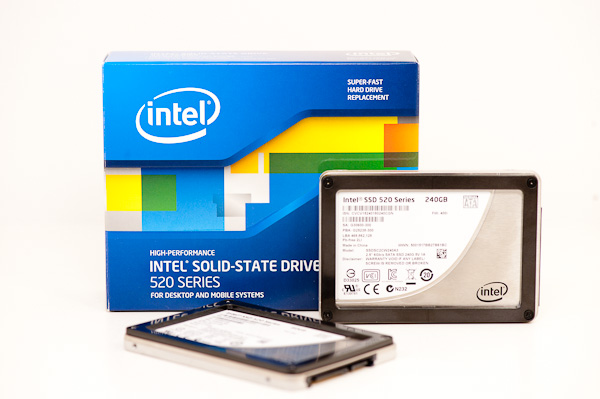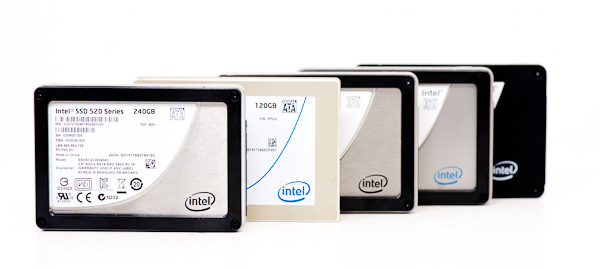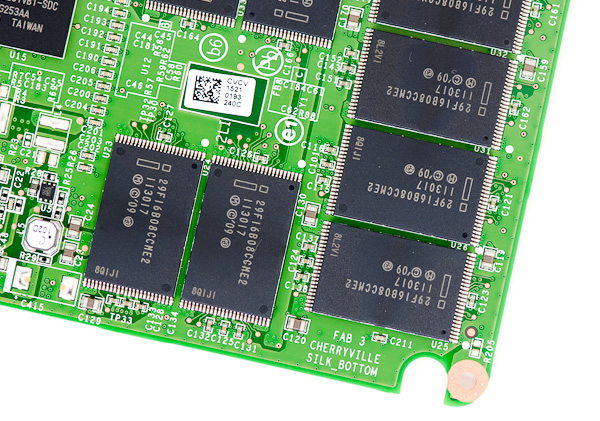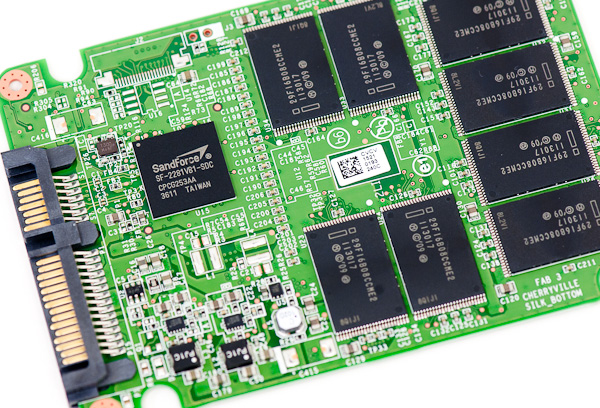Intel SSD 520 Review: Cherryville Brings Reliability to SandForce
by Anand Lal Shimpi on February 6, 2012 11:00 AM ESTIntel was rumored to be working on a SandForce based drive for several months now, but even the rumors couldn't encapsulate just how long Intel and SF has worked on this drive. According to Intel, the relationship began 1.5 years ago. Still lacking a 6Gbps controller of their own and wanting to remain competitive with the rest of the market, Intel approached SandForce about building a drive based on the (at the time) unreleased SF-2281 controller. Roughly six months later, initial testing and validation began on the drive. That's right, around the time that OCZ was previewing the first Vertex 3 Pro, Intel was just beginning its extensive validation process.
Codenamed Cherryville, Intel's SSD 520 would go through a full year of validation before Intel would sign off on the drive for release. In fact, it was some unresolved issues that cropped up during Intel's validation that pushed Cherryville back from the late 2011 release to today.
Intel's strenuous validation will eventually make SandForce's drives better for everyone, but for now the Cherryville firmware remains exclusive. Intel wouldn't go on record with details of its arrangement with SandForce, but from what I've managed to piece together the Intel Cherryville firmware is exclusive for a limited period of time. That exclusivity agreement likely expires sometime after the SF-2281 is replaced by a 3rd generation controller. There are some loopholes that allow SandForce to port bug fixes to general partner firmware but the specific terms aren't public information. The important takeaway is anything fixed in Intel's firmware isn't necessarily going to be fixed in other SF-2281 based drives in the near term. This is an important distinction because although Cherryville performs very similarly to other SF-2281 drives, it should be more reliable.
As Intel has been working on this firmware for quite a while, it's likely that the 520 uses an older branch of the SF-2281 firmware that has been updated over the past twelve months.
The BSOD is Back, but Not on Intel
Back in October SandForce announced that it had discovered a firmware issue that resulted in unexpected BSODs on SF-2281 drives on certain platforms. Why it took SandForce several months to discover the bug that its customers had been reporting for a while is a separate issue entirely. SandForce quickly pushed out the firmware to OCZ and other partners. Our own internal testing revealed that the updated firmware seemed to have cured the infamous BSOD.
Just as background, our SSD testing is rarely over once the review goes live. Any drive we recommend gets tossed into a primary use machine somewhere within the company. We keep track of drive behavior, including any bugs or performance issues over time. This long term testing process takes place over months. The results of these long term tests are folded into future reviews and recommendations.
The BSOD is caused by a bug in SandForce's power state logic that ultimately results in the drive disconnecting from the system while it's running. It turns out that Windows isn't a fan of you hot un-plugging the drive it's running on, which results in the BSOD. We had two systems that exhibited the BSOD, both of which were fixed by the update last October.

As luck would have it, our own Brian Klug happened to come across an unexpected crash with his 240GB non-Intel SF-2281 based SSD two weeks ago when he migrated it to another machine. The crash was an F4 BSOD, similar in nature to the infamous BSOD issue from last year. While two of the systems we reproduced the BSOD bug on were cured by last year's firmware update, Brian's system (an X58/Core i7 build) was BSODing regularly playing Battlefield 3. Games end up being a great way to trigger the SF-2281 BSOD issue as they frequently switch between periods of idle and load, which does a good job of stressing the power state logic in SandForce's firmware. I immediately sent Brian an Intel SSD 520 to see if the BSOD remained on Intel's drive. Switching to Cherryville caused Brian's BSODs to go away. Indeed most end user reports of SF-2281 BSODs went away with the fixed firmware, but we've still heard of isolated issues that remain unresolved. Whatever Intel has done with the 520's firmware seems to have fixed problems that still remain in the general SF-2281 firmware.
This is actually a dangerous precedent as it means one of two things. The first possibility is that SandForce has been made aware of flaws in its current firmware and chooses against (or is legally prevented from) disclosing it to its partners. The second possibility, and arguably even worse for SandForce, is that Intel was able to identify and fix a bug in the SF-2281 firmware without SandForce knowing it existed or was addressed. I suspect it's the former but as no one is willing to go on the record about the Intel/SandForce agreement I can't be certain.
Intel did go on record saying that the 520 is expected to have far fewer F4/F7 BSODs than any other SF-2281 drive. I asked Intel if I should read into the phrase "far fewer", but the answer was no - the 520 is expected to have similar reliability to the Intel SSD 510 and 320.
At the end of the day that's what Intel really brings to the table with the 520. As you'll soon see, performance isn't very different compared to other SF-2281 based drives. Intel's biggest advantage comes from the unique firmware that ships with the drive. Intel is also quick to point out that while other SF-2281 manufacturers can purchase the same Intel 25nm MLC NAND used on the 520, only Intel's drives get the absolute highest quality bins and only Intel knows how best to manage/interact with the NAND on a firmware level. While it's nearly impossible to prove most of this, the fact that we're still able to reproduce a BSOD on the latest publicly available SF-2281 firmware but not on the SF-2281 based Intel SSD 520 does say a lot about what you're paying for with this drive.
And you are paying a premium for the 520 compared to other SF-2281 based SSDs on the market today:
| Intel SSD 520 Price Comparison | |||||||
| 60GB | 120GB | 180GB | 240GB | 480GB | |||
| Intel SSD 520 (SF-2281) | $149 | $229 | $369 | $509 | $999 | ||
| Kingston HyperX (SF-2281) | N/A | $205 | N/A | $420 | N/A | ||
| OCZ Vertex 3 (SF-2281) | $95 | $190 | $240 | $375 | $850 | ||
| Samsung SSD 830 | $110 | $220 | N/A | $360 | $800 | ||
Last year Intel hinted at a move from the consumer market to enterprise server and client markets. The 520's higher price likely won't matter there, but for consumers the higher price is noticeable - particularly with good options from companies like Samsung now available on the market.














138 Comments
View All Comments
frank1985 - Monday, February 13, 2012 - link
I am a customer of this guy, and I had to return my $240 Corsair Force 2 drive/paperweight *11 days* after purchase (at which point I traded it in for his old OCZ Vertex2 which has been running without issue).Like Iketh, the fact that you can't recover performance with TRIM is a showstopper for me. I'm going to stick with the 320 series drives - they might be slower, but TRIM does what it's supposed to.
Wolfpup - Monday, July 23, 2012 - link
The TRIM issue worries me too. Sounds like it's even worse than on Micron/Crucial's M4?My 320's been great, though annoyingly the 600GB version is MASSIVELY more than the 480GB 520, or the 512GB M4...possibly because of this issue?
Ratman6161 - Wednesday, February 8, 2012 - link
I have an OCZ drive based on the SF22xx. For the first month it was nothing but trouble. Then with the release of the 2.15 firmware, suddenly all the problems went away like magic. It could simply be that OCZ paid the price for being early adopters and released to the market a product that really should have been a Beta version. Now that it has the firmware that it should have had from the beginning, everything is fine.Intel has waited until the product is more mature so its no surprise they aren't seeing these problems
Wolfpup - Monday, July 23, 2012 - link
Did you read the article? Intel explicitly fixed problems still present in other firmware.ckryan - Tuesday, February 7, 2012 - link
The Samsung 830 is maybe the finest consumer drive released in all of 2011. There is no shame in going Samsung, and in my mind, it's a fine alternative to almost every drive out there.Samsung and Micron probably have to wonder how Intel gets all the press about their NAND being better. As far as I can tell, Samsung's 27nm Toggle in the 830 is pretty damn good. The Micron NAND used in Micron's own drives is fantastic, and of course Intel's top shelf NAND is good too. But only Intel gets the press for having excellent NAND in it's own drives.
I don't think enough emphasis is placed on the NAND. You can't get a clear picture of NAND quality through benchmarking.
krumme - Monday, February 6, 2012 - link
Exit Intel from the controller market. No wrapping in reliability, as rightfully as it is, can change that fact seen from here.Anyway, Intel can earn on the memory, as was probably the plan from day 1. We will see how profitability is here in 5 years time.
tipoo - Monday, February 6, 2012 - link
I still get a kick out of how a relatively tiny startup company makes better performing parts than the chipzilla that is Intel. Good call working with them.Makaveli - Monday, February 6, 2012 - link
What I think you are missing is that Intel doesn't because they don't have to or care to. Intel is a huge company with equally big profit margins to maintain for their shareholders. The SSD market is still a small compared to the other things they dabble in. And yes they produced a controller in the past but I don't think the Money and R&D was worth it for them to continue based on the profits needed to keep them interested. We already know they make a ton of money selling nand as is.So to sum it up they could easily put out a controller that would be superior but just don't care too at the moment.
Kevin G - Monday, February 6, 2012 - link
Intel's plan was to gain control of the entire SSD product: from flash (joint venture with Micron), to the controller and to the firmware. It does appear that their original plan has fallen apart due to delays with their custom controllers which has forced them to use 3rd party controllers.I wouldn't say that Intel has stopped investing into developing their own controllers though. Intel can offer a level of integration that no other vendor can offer: direction integration into an x86 SoC. I strongly suspect that the successor to Haskwell and future Atom SoC will come with a direct ONFI connectivity backed by an internal Intel controller.
At that point in time, I suspect that SSD controllers will become akin to what discrete GPU's are today: a midrange or high end item for consumers.
NitroWare - Wednesday, February 8, 2012 - link
People forget Intel was one of the innovators in bringing MATURE Flash to consumer technologies.Intel Desktop and OEM motherboards have used their surface mount flash chips for PC BIOS since 1996. This setup provided a recovery mode to get out of BIOS corruption. To this day, excluding motherboards with dual BIOS no motherboard has the same robust recovery system as Intel boards do.
If the recovery mechanism fails then there is a more serous failure anyway.
At the time other vendors were still using older DIP socket EEPROM and some still do now , only changing to serial format ROM.
Even for current ASUS Flagship ROG boards, the best failsafe they offer is a socketed BIOS.
Intel offered those Turbo Boost Flash cards several years ago for the 1156 motherboards and laptops which did not take off. They also championed Hybrid HDD for portables.
So I think Intel know what they are doing with solid state, but yes eventually the technology will become commodity